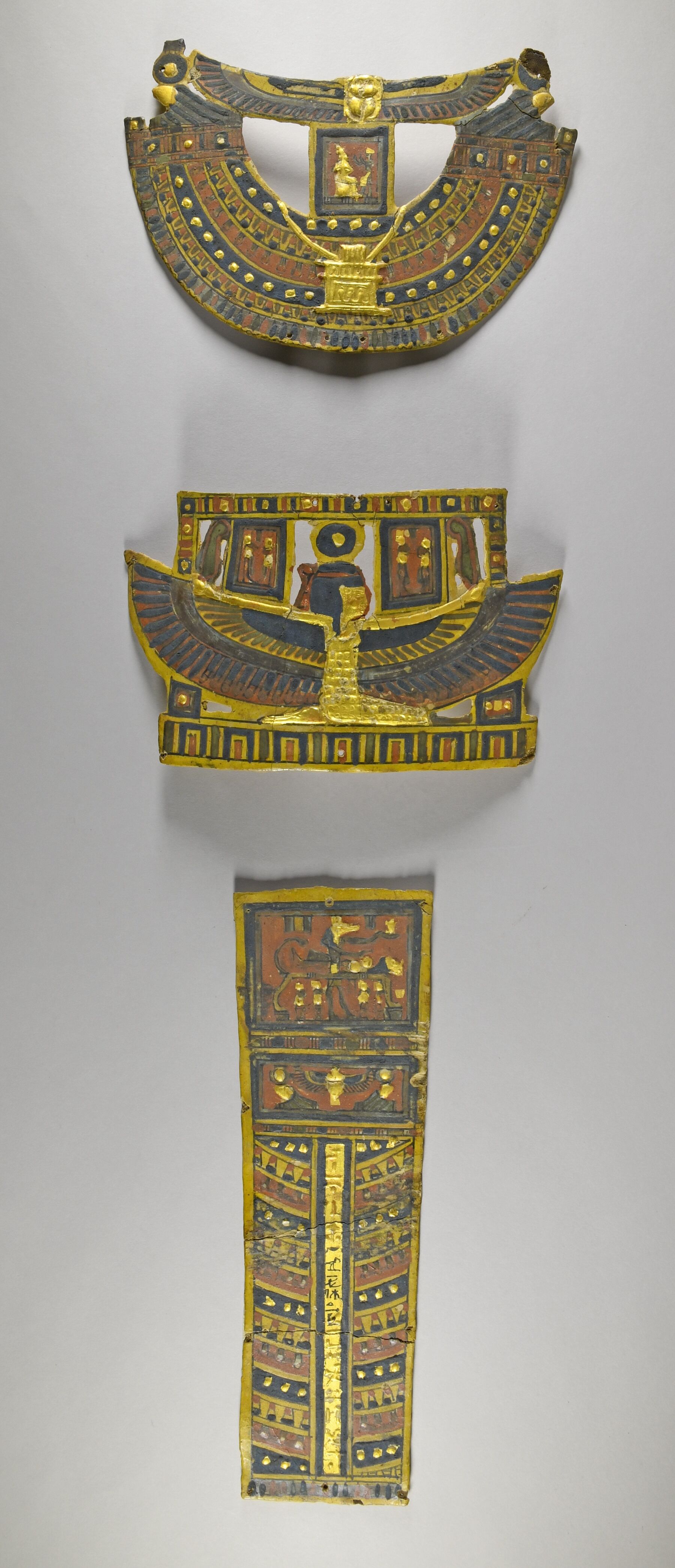Cartonnage elements such as chest and leg trappings, foot cases, and masks adorned wrapped mummies during the Ptolemaic and Roman periods. They are composed of layers of linen or papyrus, gesso, and glue that were molded, brightly painted, and often gilded.1 As with cartonnage masks, the essential components could vary based on shape, size, time, and place.
This cartonnage ensemble remains unfinished. Thin squares of gold foil were glued on faces, figures, and other important elements and were not trimmed back. On the central text band is the owner’s name, “Kagemni born of Ta’a,” painted in black, indicating the cartonnage was mass-produced and tailored for the purchaser. Holes in each element were used to sew them to the mummy wrappings.
The usekh, or broad collar, held amuletic properties in ancient Egypt.2 The collar comprises rows of floral element beads and gilded rosettes with an outer row of drop beads. The collar terminates in falcon heads wearing sun disks. Remains of gilding appear on the falcon heads and crowns. Suspended at the center of the collar is a golden pectoral with three schematic seated deities below a cavetto cornice. A square kiosk above shows the deceased worshiping a seated gilded Osiris. A winged gilded scarab tops the entire assemblage.
The chest element depicts the goddess Nut with her wings outstretched. The goddess wears a golden solar disk tied with a red fillet atop her blue wig. In her hands, she holds ma’at feathers. Her gilded dress is molded to indicate beading. The four sons of Horus stand above her wings, contained in square shrines. A color block of blue and red stripes interspersed with golden rosettes frame Isis. A painted palace façade design is below her. All elements are painted on a yellow background.
The leg trapping has three registers and a central band of text. A red and blue block border separates the registers. The jackal-headed god Anubis holds the deceased’s heart on a red background. He gestures toward the mummy lying on a lion-headed bier. Gilding decorates the heart, Anubis’s head and kilt, the head of the mummy and the lion, and the bodies and heads of the four sons of Horus below the bed. The next register contains a golden scarab with painted wings rising between two golden falcon heads with sun disks. Below, a row of golden rosettes on blue ground alternate with floral friezes on yellow or red ground. A central band of raised gilt text reserves a space for Kagemni’s name and parentage and is bordered by blue and yellow lines. The leg trapping ends with a painted row of drop beads.
The overall manufacture of the trappings is reminiscent of third century BCE cartonnage workshops located near Herakleopolis and necropolises like Abusir el-Meleq.3
MH
-
Vandenbeusch, Marie, Daniel O’Flynn, and Benjamin Moreno. 2021. “Layer by layer: the manufacture of Graeco-Roman funerary masks.” JEA 107 (1-2): 281–298. https://doi.org/10.1177/03075133211050657. ↩︎
-
Eaton-Krauss, Marianne. 1982. “Broad Collar Necklace.” In Egypt’s Golden Age: The Art of Living in the New Kingdom 1558-1085 B.C., edited by Anonymous, 234. Boston: Museum of Fine Arts.. ↩︎
-
Jonathan Elias, pers. comm. ↩︎
Bibliography
- Eaton-Krauss 1982
- Eaton-Krauss, Marianne. 1982. “Broad Collar Necklace.” In Egypt’s Golden Age: The Art of Living in the New Kingdom 1558-1085 B.C., edited by Anonymous, 234. Boston: Museum of Fine Arts.
- Vandenbeusch, O’Flynn, and Moreno 2021
- Vandenbeusch, Marie, Daniel O'Flynn, and Benjamin Moreno. 2021. “Layer by layer: the manufacture of Graeco-Roman funerary masks.” JEA 107 (1-2): 281–298. https://doi.org/10.1177/03075133211050657
